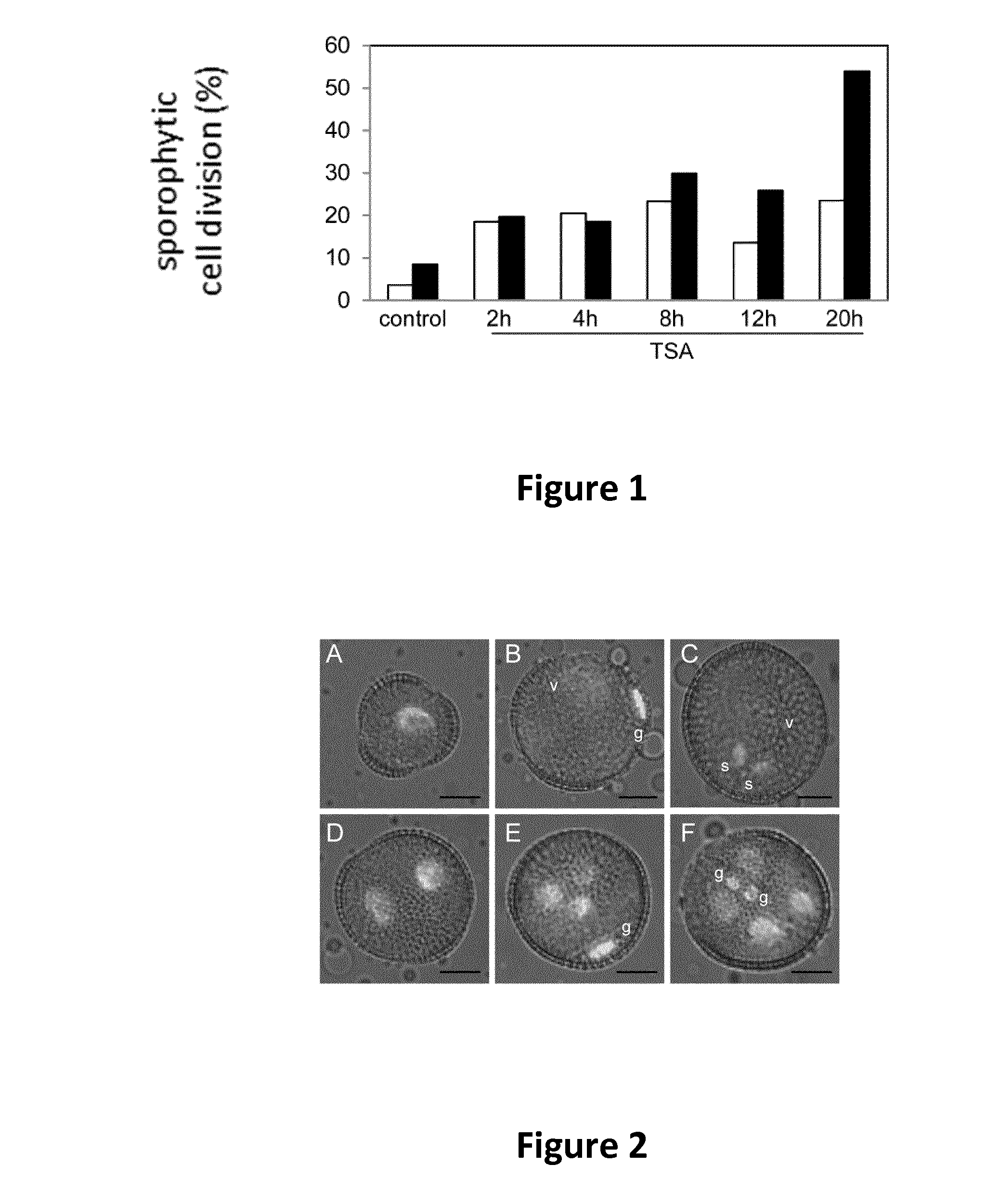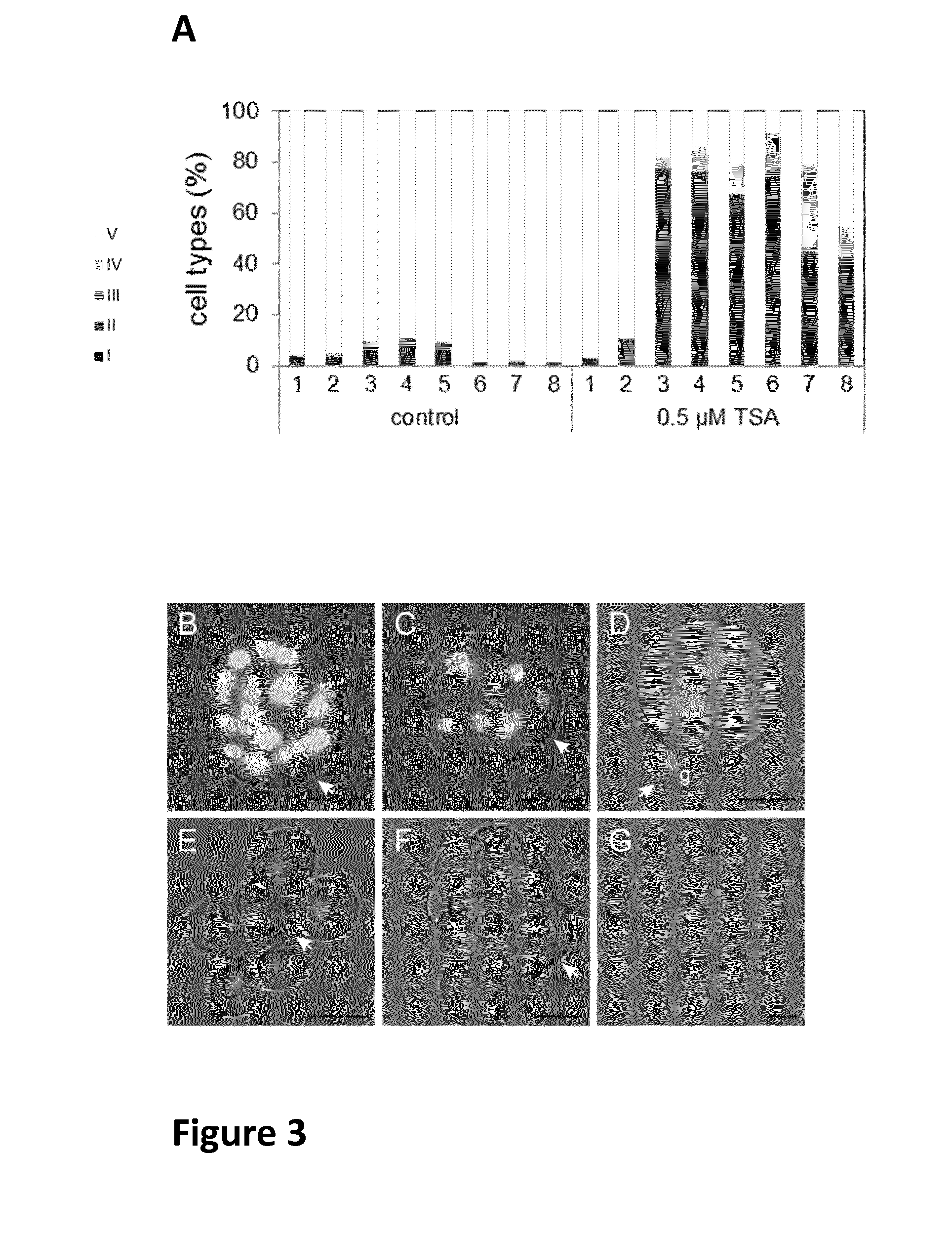Haploid embryogenesis
a technology of haploid embryogenesis and plant embryos, applied in the field of plant breeding, can solve the problems of reducing the breeding period, difficult to develop a unified concept of the totipotent plant cell, and unable to reveal traits controlled by recessive alleles, etc., and achieve the effect of improving the conversion
- Summary
- Abstract
- Description
- Claims
- Application Information
AI Technical Summary
Benefits of technology
Problems solved by technology
Method used
Image
Examples
example 1
TSA Induces Hyperproliferation in Poorly Responsive B. napus Genotype, DH12075
[0119]Cultured microspores and pollen of B. napus genotype, DH12075 were treated with the HDAC inhibitor, TSA. We examined the development of microspore cultures by staining heat-stressed (hereafter referred to as control) and heat-stressed plus TSA-treated immature male gametophytes at different developmental stages with the nuclear dye, DAPI. Initial dosage experiments were used to establish the minimal exposure time (20 h) in relation to the specific phenotypes discussed below.
[0120]FIG. 1. Effect of the duration of TSA treatment on sporophytic cell division in B. napus DH12075 microspore culture. Immature male gametophytes from two different bud sizes (black bars and white bars) were cultured in the presence of 0.5 μM TSA or with the equivalent volume of DMSO (control) at 33° C. Sporophytic cell divisions were counted after DAPI staining after five days of culture. Treatments for longer than 20 hours d...
example 2
TSA and Heat-Stress Induce Similar Developmental Changes
[0125]The developmental fate of heat-stressed control cultures and cultures exposed to both heat-stress and TSA was followed by examining older cultures in more detail. Initial experiments showed that the proportion of dividing cells, as well as their developmental fate was influenced by the concentration of TSA that was applied to the culture. Heat-stressed microspores and pollen were treated with a range of TSA concentrations and the cultures examined after five and 15 days using DAPI staining to characterize the different multicellular structures that developed.
[0126]FIG. 3 shows the effect of TSA on sporophytic growth in B. napus microspore culture. (A)=percentage of cells that had divided gametophytically (white bars) or sporophytically (grey bars) after five days of microspore culture. The corresponding structures are shown in FIG. 3 B-E (has scale bar of 20 μm) where FIG. 3(B-G) shows images of type I-IV sporophytic stru...
example 3
Sporophytic Cell Clusters are Embryogenic
[0134]The cell clusters that are formed in heat-stressed, TSA treated cultures resemble those found in control cultures that are only exposed to a heat-stress treatment. They include classical embryogenic structures, as well as structures that have been classified as non-embryogenic based on their unorganized structure, early release from the exine, and the lack of a protoderm, which is known to considered a hallmark for commitment to embryo development in culture. Semi-quantitative RT-PCR and GFP reporter lines were used to determine whether the different types of sporophytic structures that develop in control and TSA-treated cultures are embryogenic.
[0135]The expression of four embryo-expressed transcription factors genes, BABY BOOM (BBM); LEAFY COTYLEDON1 (LEC1); LEC2 and FUSCA3 is known to be positively correlated with the embryogenic potential of B. napus microspore cultures. Semi-quantitative RT-PCR analysis showed that expression of th...
PUM
 Login to View More
Login to View More Abstract
Description
Claims
Application Information
 Login to View More
Login to View More - R&D
- Intellectual Property
- Life Sciences
- Materials
- Tech Scout
- Unparalleled Data Quality
- Higher Quality Content
- 60% Fewer Hallucinations
Browse by: Latest US Patents, China's latest patents, Technical Efficacy Thesaurus, Application Domain, Technology Topic, Popular Technical Reports.
© 2025 PatSnap. All rights reserved.Legal|Privacy policy|Modern Slavery Act Transparency Statement|Sitemap|About US| Contact US: help@patsnap.com



